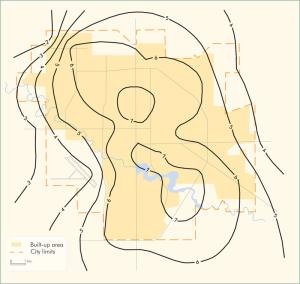
It is well known that the air in urban areas is often warmer than that in the surrounding countryside. The region of warmth created by a city is known as an urban heat island. In cities worldwide—and indeed in Saskatchewan’s two largest cities, Saskatoon and Regina—the intensity and form of the heat island effect is strongly influenced by regional climate, topography, land use, and city size.
The urban heat island effect is most pronounced on calm, cloudless evenings, when natural rural surfaces cool more rapidly than city surfaces. Heat in cities is generated by heat-retaining construction materials such as concrete, masonry and asphalt, which alter the radiative, thermal, moisture, and aerodynamic properties of the natural surface cover. Air pollution from domestic, industrial, and automobile combustion processes also contributes to urban heat. In the temperate climates of Saskatoon and Regina, urban heat island intensities are greater during the cold autumn and winter months due to heat release from anthropogenic sources such as space heating, transportation, manufacturing, and lighting.
Regina is an ideal site for urban heat island formation: its built-up area is flat, compact, and surrounded by a vast plain so that topoclimatic effects are minimal (see Figure UHI-1). In Saskatoon, cold air drainage along the South Saskatchewan River valley causes some interference in heat island genesis. However, in both cities the built environment exerts a warming influence on daily temperatures. Nocturnal air temperatures in the city centres of Regina and Saskatoon are, on average, 3–4°C warmer than in the surrounding countryside; and under ideal nocturnal heat island conditions, urban-rural temperature contrasts, measured at the same time, can reach 6–8°C. In spite of the abundance of parks and open spaces in Regina and Saskatoon, both cities exhibit a discernible heat island influence. It is expected that heat islands of lesser intensity may be detectable in smaller cities and towns throughout Saskatchewan.
The urban heat island effect has many implications for Saskatchewan’s cities. Warm urban temperatures may reduce energy requirements for space heating during winter months and increase demands for air conditioning in the summer. The heat island effect may lead to fewer frosts and a longer growing season for urban horticulturists. The survival of exotic trees, plants, animals and birds in the city may also be influenced by urban heat. The heat island effect will assume greater significance in Saskatoon and Regina with continued population growth and urban expansion.
Iain Stewart
Print EntryHOME | BROWSE BY SUBJECT | ENTRY LIST (A-Z) | IMAGE INDEX | CONTRIBUTOR INDEX | ABOUT THE ENCYCLOPEDIA | SPONSORS TERMS OF USE | COPYRIGHT © 2006 CANADIAN PLAINS RESEARCH CENTER, UNIVERSITY OF REGINA | POWERED BY MERCURY CMS |
|||
| This web site was produced with financial assistance provided by Western Economic Diversification Canada and the Government of Saskatchewan. |
|||
 |
 |
 |
 |
| Ce site Web a été conçu grâce à l'aide financière de Diversification de l'économie de l'Ouest Canada et le gouvernement de la Saskatchewan. |
|||